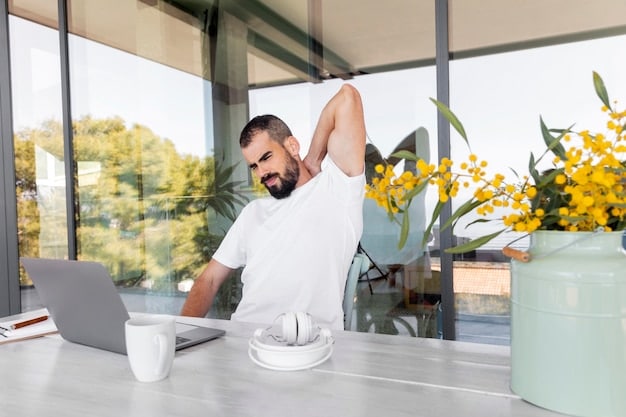Unlock Your Potential: 7-Minute Morning Mobility for 2025

7-Minute Morning Mobility routines offer a quick and effective way to enhance flexibility, reduce stiffness, and boost energy levels, setting a positive tone for the workday ahead, making them an ideal fitness solution for busy individuals in 2025.
Are you looking for a way to kickstart your day and improve your overall well-being? The 7-Minute Morning Mobility: Unlock Your Body’s Potential Before Work in 2025 is a game-changer. This routine is designed to quickly energize your body, enhance flexibility, and prepare you for a productive day.
Why Morning Mobility Matters
Incorporating morning mobility exercises into your daily routine can significantly improve your physical and mental health. Mobility focuses on increasing the range of motion in your joints, which is crucial for preventing injuries and improving athletic performance. But why prioritize it in the morning?
Starting your day with mobility exercises helps to counteract the stiffness that can accumulate overnight. It also boosts circulation and prepares your body for the physical demands of the day, whether you’re sitting at a desk or engaging in more active tasks.
Benefits of Improved Mobility
Enhanced mobility offers several key advantages, affecting both your physical and mental well-being. Here are some of the most notable benefits:
- Reduced risk of injuries: Greater flexibility and range of motion make you less susceptible to strains and sprains.
- Improved posture: Mobility exercises help to align your body correctly, reducing the strain on your back and neck.
- Increased energy levels: By improving circulation and reducing stiffness, mobility exercises can make you feel more energetic throughout the day.
- Better athletic performance: Whether you’re a weekend warrior or a competitive athlete, improved mobility can enhance your performance and reduce recovery time.
By focusing on mobility, you’re not just stretching; you’re actively working to improve how your body moves and feels. This proactive approach can lead to long-term benefits that extend far beyond your morning routine.

The 7-Minute Morning Mobility Routine
This routine is designed to be quick, efficient, and effective. It targets major muscle groups and joints, helping you to improve flexibility and range of motion in just seven minutes. Each exercise should be performed for about 45 seconds, followed by a 15-second rest period.
Remember to listen to your body and stop if you feel any pain. Consistency is key, so try to do this routine every morning for the best results. With regular practice, you’ll start to notice improvements in your flexibility and overall well-being.
Exercises Included
The 7-minute mobility routine includes a variety of dynamic stretches and movements designed to target different areas of your body:
- Neck Rolls: Gently rotate your head clockwise and counterclockwise to loosen neck muscles.
- Shoulder Circles: Rotate your shoulders forward and backward to improve mobility and reduce tension.
- Arm Swings: Swing your arms across your body and overhead to increase shoulder range of motion.
- Torso Twists: Twist your torso from side to side to loosen your spine and improve flexibility.
These exercises are designed to be gentle yet effective, making them perfect for starting your day. They can help to improve circulation, reduce stiffness, and prepare your body for the physical demands of the day ahead.
Customizing Your Routine
While the standard 7-minute routine is a great starting point, it’s important to customize it to fit your individual needs and preferences. This might involve adding or substituting exercises based on your specific goals or limitations.
Consider where you tend to feel the most stiffness or tension. If you spend a lot of time sitting, you might want to focus on exercises that target your hips, back, and shoulders. If you have specific injuries or conditions, work with a physical therapist to develop a routine that’s safe and effective for you.
Modifications and Substitutions
Here are a few ways you can modify or substitute exercises to better suit your needs:
- If neck rolls are uncomfortable, try chin tucks instead.
- If you have shoulder pain, replace arm swings with gentle pendulum exercises.
- For lower back issues, focus on cat-cow stretches or pelvic tilts.
- If standing exercises are difficult, perform the routine seated.
By tailoring the routine to your individual needs, you can maximize its benefits and minimize the risk of injury. Remember, the goal is to improve your mobility and feel better, so don’t be afraid to experiment and find what works best for you.
Tracking Your Progress
Monitoring your progress is essential for staying motivated and ensuring that your morning mobility routine is effective. Keeping track of your flexibility and range of motion can help you to identify areas where you’re improving and areas where you might need to focus more attention.
There are several ways to track your progress, from simple methods like taking notes to more sophisticated approaches using technology. Choose a method that works for you and make it a regular part of your routine.

Methods for Tracking Mobility
- Take photos or videos: Periodically record yourself performing the exercises to visually track changes in your flexibility.
- Use a mobility tracking app: Several apps are designed to help you monitor your range of motion and flexibility.
- Keep a journal: Write down how you feel before and after each session, noting any improvements or areas of discomfort.
- Work with a physical therapist: A therapist can assess your mobility and provide personalized feedback and guidance.
By consistently tracking your progress, you’ll be able to see the tangible benefits of your morning mobility routine. This can help you to stay motivated and committed to achieving your goals.
Overcoming Common Challenges
Even with the best intentions, it can be challenging to stick to a morning mobility routine. Common obstacles include lack of time, motivation, and space. However, with a little planning and creativity, you can overcome these challenges and make mobility a sustainable part of your daily life.
Consider setting realistic goals, finding a routine that you enjoy, and creating a dedicated space for your exercises. Enlist the support of friends or family members, and celebrate your successes along the way.
Tips for Staying Consistent
Here are some practical tips to help you stay consistent with your morning mobility routine:
- Set a specific time each day: Choose a time when you’re least likely to be interrupted and make it a non-negotiable part of your schedule.
- Prepare in advance: Lay out your exercise clothes and equipment the night before to make it easier to get started.
- Make it enjoyable: Choose exercises that you find enjoyable and create a positive and motivating environment.
- Track your progress: Monitoring your progress can help you to stay motivated and committed to your goals.
By implementing these strategies, you can increase your chances of sticking to your routine and reaping the many benefits of improved mobility.
The Future of Morning Mobility in 2025
As we look ahead to 2025, the future of morning mobility is likely to be shaped by advancements in technology and a growing awareness of the importance of holistic health. We can expect to see more personalized routines, virtual coaching, and wearable devices that track and optimize our mobility.
The integration of AI and machine learning will enable us to create routines that are tailored to our individual needs and preferences. Virtual reality and augmented reality technologies will provide immersive and engaging exercise experiences, making it easier and more enjoyable to stay active.
Technological Advancements
Here are some of the technological advancements that are likely to impact morning mobility in the coming years:
- AI-powered personalized routines: AI algorithms will analyze data from wearable devices and other sources to create routines that are tailored to your individual needs and goals.
- Virtual coaching: Virtual coaches will provide real-time feedback and guidance, helping you to perform the exercises correctly and safely.
- Wearable devices: Wearable devices will track your range of motion, flexibility, and other metrics, providing valuable insights into your progress.
- Virtual reality and augmented reality: These technologies will create immersive and engaging exercise experiences, making it easier and more enjoyable to stay active.
With these advancements, morning mobility routines will become more accessible, effective, and enjoyable than ever before.
Integrating Mobility into Your Workday
While a 7-minute morning routine is a great start, it’s also important to integrate mobility into your workday. Taking short breaks throughout the day to stretch and move can help to prevent stiffness, reduce fatigue, and improve your overall well-being.
Consider setting reminders to get up and move every hour, and incorporate simple stretches and exercises into your routine. Even a few minutes of movement can make a big difference in how you feel.
Easy Workplace Mobility Exercises
Here are some easy exercises you can do at your desk to improve mobility throughout the day:
- Seated Torso Twists: Twist your torso from side to side while seated to loosen your spine.
- Shoulder Blade Squeezes: Squeeze your shoulder blades together to improve posture and reduce tension in your upper back.
- Wrist Stretches: Extend your arms and gently bend your wrists up and down to improve flexibility.
- Ankle Circles: Rotate your ankles clockwise and counterclockwise to improve circulation and prevent stiffness.
By incorporating these simple exercises into your workday, you can maintain your mobility and prevent the negative effects of prolonged sitting.
| Key Point | Brief Description |
|---|---|
| 💪 Quick Start | Enhance your day with a 7-minute morning mobility routine. |
| 🧘 Improved Mobility | Reduces injury risk, enhances posture, and boosts energy levels. |
| ⏱️ Time-Efficient | Fits easily into busy schedules, requiring only 7 minutes. |
| 📈 Progress Tracking | Monitor flexibility and range of motion to stay motivated. |
Frequently Asked Questions
▼
Morning mobility refers to exercises and stretches performed to improve joint range of motion and reduce stiffness, preparing the body for daily activities.
▼
Morning is ideal because muscles and joints can be stiff from sleep. Mobility exercises get blood flowing, enhancing flexibility and energy levels for the day.
▼
A 7-minute routine is a great starting point. It’s quick enough to fit into a busy schedule while still providing significant benefits.
▼
Yes, customize it based on your needs. Focus on areas where you feel stiffness or tension, and adjust exercises to accommodate any limitations.
▼
Expect AI-powered routines, virtual coaching, and wearable tech for personalized and effective mobility training, making it more accessible and engaging.
Conclusion
Incorporating a 7-Minute Morning Mobility routine into your daily life is an investment in your overall health and well-being. By taking just a few minutes each morning to improve your flexibility and range of motion, you can reduce your risk of injuries, improve your posture, and boost your energy levels. As we look ahead to 2025, the advancements in technology promise to make morning mobility even more accessible and effective. Start today and unlock your body’s potential!





